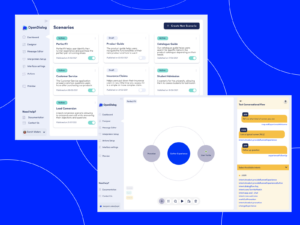Conversational AI agents are now a must-have for boosting customer experiences and streamlining operations. A key decision in any AI strategy is whether to build a custom solution or use an all-in-one platform.
It’s a major choice, and the pros and cons deserve serious thought. Too often, the decision gets oversimplified to “let’s just plug into an LLM provider like OpenAI.” Fast forward a few months, and it becomes clear that this approach was a huge understatement. What seemed like a simple “wraparound” turns into a much more complex challenge. This issue gets compounded by two forces at play: the ease of spinning up a quick demo and the passion of a “solo architect” or small team determined to take their creation from demo to production.
That doesn’t mean you should rule out building your own solution. But you need to enter the process with eyes wide open about what’s involved and when it makes sense. This article breaks down the benefits and challenges of both paths to help you make an informed choice.
Build-Your-Own Conversational AI System
Building your own conversational AI system can offer some important benefits, particularly in terms of control and flexibility. Businesses can fully customize the solution to meet specific needs, integrating tailor made features and workflows in a way that aligns closely with a company’s infrastructure, Another key advantage is data ownership. By building in-house, companies maintain complete control over how data is collected, stored, and used. Naturally, this advantage comes with the commensurate responsibility.
Additionally, long-term cost-efficiency may be a benefit, if there is sufficient scale. Although initial development and infrastructure costs will be high, owning the system eliminates ongoing platform subscription fees. Depending on the scale of the problem solved that equation may work in favor of a build-your-own solution.
On the other side of the cost-efficiency equation are the costs of recruiting and maintaining a highly skilled team that will be able to keep developing and evolving your AI agents as well as the costs of ongoing monitoring and maintenance capabilities. As you can imagine, there can be a significant difference between the costs for a team that maintains an agent within a platform and a team that has to develop the platform and maintain the solutions built on top of it.
The financial outlay for a team of several developers, designers and product managers skilled in AI systems is, of course, demanding and the fast pace with which AI technologies develop and the steep competition for AI talent means that there will be an ongoing economic pressure on the organization.
Overall, organizations have to weigh the freedom and power that total control and ownership can provide against the responsibilities that come with maintaining in-house teams and systems to deliver this control. This approach is ideal for companies that have highly complex needs and the resources to manage their own AI development teams at scale over a multi-year period.
Using an All-In-One Conversational AI Platform
Using an all-in-one platform for conversational AI offers several practical advantages, especially for businesses looking to launch quickly, efficiently, and scale without hassle.
One of the main benefits is speed to deployment. These platforms typically come with ready-made tools, like no-code interfaces and easy integrations with third-party systems, plus built-in analytics and front-end frameworks. This reduces the time spent on development, allowing companies to focus on improving customer interactions rather than building complex infrastructure.
Cost savings are another advantage. With an all-in-one platform, businesses can avoid the need for a large in-house team of developers and data scientists, relying instead on the platform’s built-in functionalities, which can lower the initial costs compared to building a custom solution. In addition, there is a broader pool of specialists available to help maintain and continue to develop a solution.
Scalability is also a key benefit. These platforms are designed to grow with your needs, whether that’s handling more interactions or adding new features, without the need for significant infrastructure changes.
Additionally, most platforms are regularly updated by their providers, so you benefit from the latest advancements in AI without needing to manage updates yourself.
All-in-one platforms often come with strong support and maintenance options, including customer service, training, and analytics, making it easier to manage and optimize your AI agents over time.
Finally, it is worth discussing the innovation and customisation aspect. While it is true that with a custom platform you get to customize as much as you need it is also true that you are trying to design a system with limited information. The creators of all-in-one platforms see feature requests and needs from across many different clients, while you simply don’t know what you don’t know. This is what leads custom platforms to keep rediscovering the wheel rather than focussing on true innovation. With an all-in-one platform you get to focus on what will make your application special, rather that solving problems that have already been solved.
For businesses seeking a quick, cost-effective, and scalable AI solution, using an all-in-one platform is a practical option.
Lessons from Other Spaces
Conversational AI isn’t the first technology space to grapple with the build-or-buy question. If you look at the evolution of other tech—like CRM software or content management systems—a familiar pattern emerges. In the early days, it’s a gold rush. Everyone’s building custom solutions, trying to innovate and leverage cutting-edge ideas. At that stage, custom seems like the only option because all-in-one platforms are still finding their footing.
But fast forward a few years, and the landscape changes. Organizations start abandoning custom builds in favor of off-the-shelf solutions. Take content management systems (CMS) for example—how many companies today are still running their websites on fully in-house CMS platforms? Not many. Exclude the behemoths like Google, AWS, or Facebook that have their own massive infrastructures, and you’re left with an internet largely powered by a handful of CMS platforms.
Think about it—WordPress alone runs about 42% of the web. Add in platforms like Drupal, Squarespace, and Wix, and it’s clear: unless you’re Apple or another mega-corporation with a specific need for full control, the majority of organizations are perfectly content with pre-built solutions. The custom builds? They’ve become the rare exception, reserved for a select few who can justify the effort and cost of maintaining full ownership.
The lesson is clear: in the early days, custom solutions might seem necessary, but as the tech matures, most businesses opt for platforms that let them focus on results, not the plumbing underneath.
Conclusions
Let’s get the elephant in the room out of the way—I’m the co-founder of OpenDialog, an all-in-one platform for Conversational AI. So, yes, I’m naturally leaning toward one side of this debate. But here’s the thing: the arguments speak for themselves.
If we look at how other technologies have evolved and consider the realities of maintaining a custom platform, it becomes pretty clear that building your own is an uphill battle—unless you’re operating at massive scale and ready to commit to a multi-year investment. And even then, it still makes sense to start with an off-the-shelf solution. Why? Because it’s the quickest way to figure out if your specific needs really require a custom build, or if an existing platform already ticks most of your boxes.
For most companies, in-house solutions just don’t stack up when a solid, proven alternative exists. And for those rare cases where building your own might be justified, starting with an off-the-shelf platform gives you a baseline. You get to explore the space, see what you’d need to replicate or improve upon before diving into the complexities of a fully custom solution.
No matter which path you’re leaning toward, you can test-drive OpenDialog today and see how to build Conversational AI Agents quickly, efficiently, and at scale—without reinventing the wheel.
Summary of Decision Factors
Here’s a pros and cons list for both building a custom conversational AI system and using an all-in-one platform, based on the points we’ve discussed:
Building a Custom Conversational AI System
Pros:
- Full control and flexibility: You can tailor every aspect of the solution to fit your business’s specific needs, including custom features and workflows.
- Data ownership: Complete control over how data is collected, stored, and used,
- Long-term cost efficiency (with scale): After high initial development costs, you avoid ongoing subscription fees, which could lead to savings if the system operates at sufficient scale.
- Alignment with infrastructure: You can deeply integrate the solution with your existing tech stack and infrastructure, ensuring seamless compatibility.
- Custom innovation: Allows for specific, cutting-edge innovations unique to your business that may not be possible with off-the-shelf platforms.
Cons:
- High upfront costs: Development, infrastructure, and hiring skilled developers all require a significant initial financial outlay.
- High ongoing maintenance and updates costs: The responsibility for keeping the system up to date, troubleshooting, and maintaining performance falls on your team.
- Team dependency: Your system’s future depends on the expertise and availability of your in-house team. If key members leave, the system’s longevity could be at risk.
- Scalability challenges: Scaling a custom solution can be complex, requiring further investments in infrastructure and development.
- Fast-evolving technology: Keeping up with the rapid pace of AI advancements can create ongoing pressure to innovate and adapt.
Using an All-in-One Conversational AI Platform
Pros:
- Speed to deployment: Platforms are ready to go with pre-built tools and no-code interfaces, drastically reducing the time it takes to launch.
- Lower upfront costs: The need for a large development team is minimized, as the platform provides much of the required functionality out of the box.
- Ease of scalability: These platforms are designed to scale effortlessly, letting businesses handle increased usage or add new features without significant technical overhead.
- Regular updates: Providers ensure that the platform stays current with the latest AI advancements, so you don’t have to manage updates yourself.
- Support and maintenance: Most platforms offer customer service, training, and monitoring, easing the burden of maintaining the system.
Cons:
- Less customization: While platforms are flexible, they may not offer the deep customization that some businesses require for unique workflows or features.
- Data control limitations: Depending on the provider, you may not have full control over how data is handled, which could raise compliance and privacy concerns.
- Ongoing subscription fees: While upfront costs are lower, the subscription or usage-based fees can add up over time, especially as usage scales.
- Vendor dependency: Your business becomes reliant on the platform provider for updates, support, and future features. If the provider changes direction or discontinues the service, you’re exposed to risk.
- Limited innovation: You may be constrained by the platform’s existing capabilities and roadmap, limiting the ability to innovate or implement features that aren’t yet supported.
Summary:
- Build your own offers control, flexibility, and long-term potential cost efficiency but comes with high upfront costs, maintenance challenges, and team dependency.
- Use an all-in-one platform for quick deployment, ease of scaling, and lower upfront costs, but be aware of customization limitations, vendor lock-in, and potential ongoing fees.
The best choice depends on your business needs, resources, and long-term goals.
Read more articles like this by clicking here.



